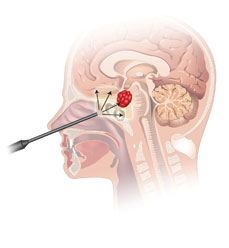SKULL BASE SURGERY

Skull Base Surgical Treatment Options
Minimally Invasive Endoscopic Surgical Techniques

Advanced Microscopic, Laser and Ultrasonic Techniques
Penn performs advanced microscopic, laser and ultrasound techniques on certain types of tumors that are buried deep within the base of the skull. The laser, for example, allows surgeons to remove these tumors in less time, decreasing risk of complications, less use of anesthesia and a reduced possibility of damage to surrounding healthy brain and nerve tissue.
Restorative and Reconstructive Facial and Skull Base Surgery
The Center for Cranial Base Surgery has a team of surgeons dedicated to restoring the functional and cosmetic elements of a patient’s health. Restorative techniques such as microvascular reconstruction, nerve and muscle grafting, facial reanimation and soft tissue restoration are implemented as an important part of a patient’s treatment and overall outcome.
Open Skull Surgery
Surgeons perform open skull surgery when necessary. This procedure may require incisions in the facial area and in the skull. Surgeons may need to remove parts of bones so that the tumor can be reached and removed. Advanced imaging is often used for this type of surgery.
Watchful Waiting
Some skull base disorders including tumors don’t require surgery and are monitored for some time to see if they grow.
Clinical Trials
Penn Medicine is a leader in research and conducts many clinical trials to discover new drugs, new surgical techniques and new devices. Clinical trials are also conducted to test cutting-edge and novel therapies. Not everyone with a disease or problem can take part in a research study. If your doctor thinks that you might qualify for a study, he or she may present it as a treatment option. Likewise, if you are interested in knowing if you qualify for a trial, please ask your healthcare provider for more information.
Radiosurgery
Radiosurgery uses beams of ionizing radiation to precisely target a tumor so that surrounding structures receive little radiation. It can serve as stand-alone therapy or in addition to a surgical resection. Many tumors, especially those that are difficult to access surgically, are treated with these techniques.
